The Kinetic Chromogenic Spectrophotometer Market is estimated to be valued at USD 1995.9 million in 2025 and is projected to reach USD 3944.7 million by 2035, registering a compound annual growth rate (CAGR) of 7.1% over the forecast period.
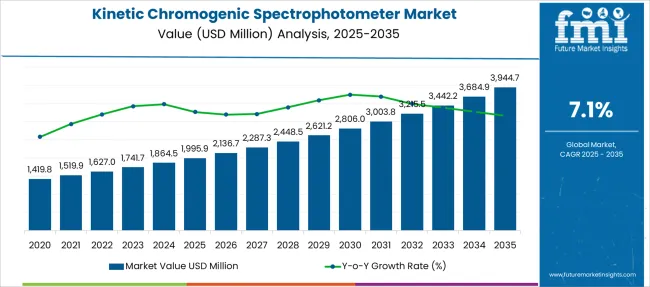
| Metric | Value |
|---|---|
| Kinetic Chromogenic Spectrophotometer Market Estimated Value in (2025 E) | USD 1995.9 million |
| Kinetic Chromogenic Spectrophotometer Market Forecast Value in (2035 F) | USD 3944.7 million |
| Forecast CAGR (2025 to 2035) | 7.1% |
The kinetic chromogenic spectrophotometer market is expanding steadily as industries seek precise analytical tools for complex sample analysis. Growing demand from industrial applications for real-time monitoring and quality control has fueled market growth.
Technological advancements have enhanced the sensitivity and speed of spectrophotometric instruments, allowing users to achieve more accurate and reliable results. The importance of rapid elemental and molecular analysis in fields such as environmental monitoring, pharmaceuticals, and food safety has also increased adoption.
Regulatory frameworks continue to emphasize stringent quality standards, driving investments in advanced analytical equipment. The market is expected to grow further as industries adopt integrated systems combining atomic and molecular spectrometry techniques. Segmental growth is projected to be led by industrial applications, with elemental analyzers dominating atomic spectrometry and IR spectrometry leading molecular spectrometry applications.
The market is segmented by Application, Atomic Spectrometry, and Molecular Spectrometry and region. By Application, the market is divided into Industrial Applications, Biotechnological Applications, Environmental Applications, and Space Applications. In terms of Atomic Spectrometry, the market is classified into Elemental Analyzers, X-ray Diffraction, and Plasma Atomic Emission Spectrometry. Based on Molecular Spectrometry, the market is segmented into IR-spectrometry, UV Visible Spectrometry, and Near infrared spectrometry. Regionally, the market is classified into North America, Latin America, Western Europe, Eastern Europe, Balkan & Baltic Countries, Russia & Belarus, Central Asia, East Asia, South Asia & Pacific, and the Middle East & Africa.
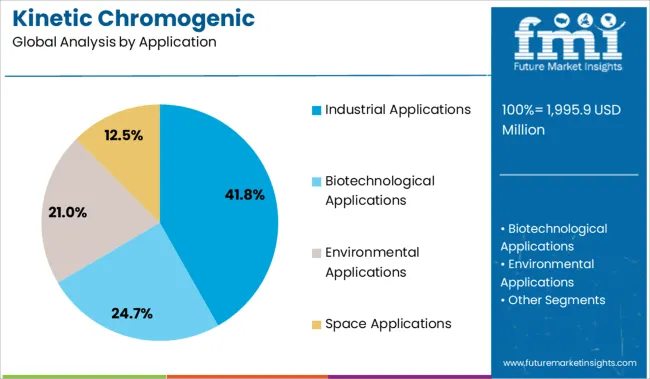
The industrial applications segment is forecasted to generate 41.8% of the market revenue in 2025, positioning it as the leading application area. This growth is driven by the wide range of industries including chemical manufacturing, environmental testing, and food processing that require precise and rapid compositional analysis.
The ability of kinetic chromogenic spectrophotometers to deliver real-time data has enhanced process monitoring and product quality assurance. Increasing adoption of automation in industrial laboratories has further boosted demand.
As industries strive to comply with regulatory standards and improve efficiency, this segment is expected to maintain its leadership in market share.
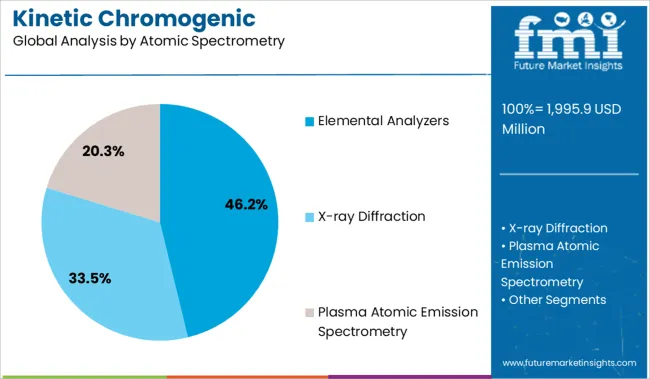
Elemental analyzers are projected to account for 46.2% of the market revenue within the atomic spectrometry segment in 2025, remaining the dominant product type. These analyzers are essential for detecting and quantifying trace elements in complex samples, critical for applications ranging from metallurgy to environmental science.
The segment’s growth is attributed to advances in detection limits and sample throughput, allowing faster and more accurate elemental analysis. The growing need for comprehensive elemental profiling in quality control and research has bolstered adoption.
With ongoing improvements in instrument sensitivity and automation, the elemental analyzers segment is expected to sustain its leading position.
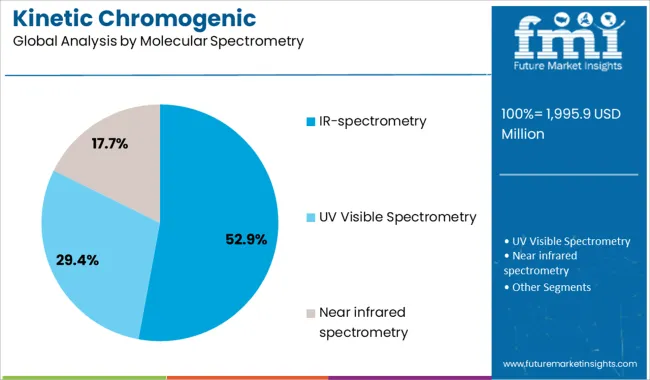
IR spectrometry is expected to hold 52.9% of the molecular spectrometry market revenue in 2025, making it the foremost technique in this segment. Its ability to provide detailed molecular fingerprinting enables qualitative and quantitative analysis of complex organic compounds.
IR spectrometry’s non-destructive nature and rapid data acquisition have made it indispensable in pharmaceuticals, polymers, and food analysis. Recent innovations improving spectral resolution and miniaturization have expanded its applications.
As industries increasingly require reliable molecular characterization tools, the IR spectrometry segment is anticipated to maintain strong market growth.
Kinetic chromogenic spectrophotometers are used in a majority of laboratories for detecting the properties and composition of several chemicals. Due to the increase in demand for drug-related study and bio-molecular analysis from the life science industry the kinetic chromogenic spectrophotometer market is advancing. Intensive research and development in the biotechnological and pharmaceutical sector is the biggest driving factor for the kinetic spectrophotometer market.
The only drawback in this commerce is its costly equipment and the lack of technical know-how on operating these devices with the elimination of these factors, the global kinetic chromogenic spectrophotometer will witness a giant development in the market province
Asia Pacific is projected to grow at a high CAGR during the forecast period due to rising demand from end-use industries, such as the environment protection industry, biotechnology industry, aerospace industry, and others. Industrialists utilize these tests to determine the level of toxicity in different environmental samples. As such it has become an essential tool for the researchers and scientists in the region.
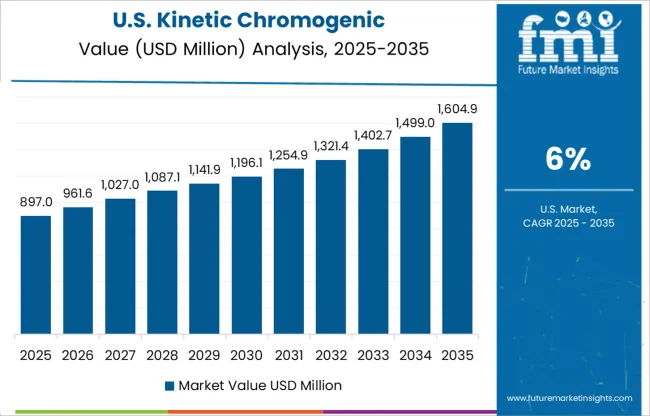
North America holds a higher market value in the kinetic chromogenic spectrophotometer market due to its increasing purchasing power, technological advancement, and widening applications in multitudinous segments eventually contributing to a better market. Moreover, upsurged growth in the pharmaceutical and food & beverage sector has boosted the demand for the Kinetic chromogen in the region.
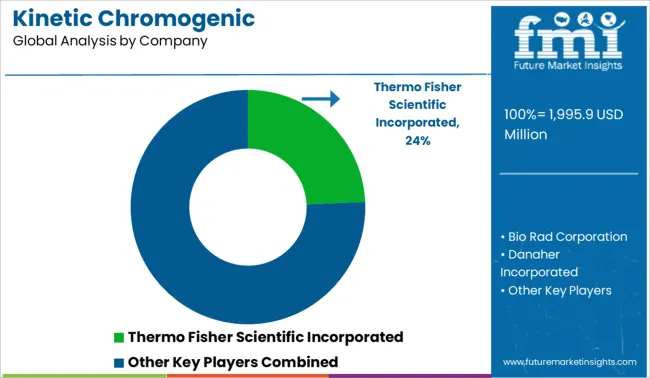
Some of the key participants present in the global demand for the Kinetic Chromogenic Spectrophotometer include Thermo Fisher Scientific Incorporated, Bio-Rad Corporation, Dahner Incorporated, Shimadzu Corporation, and Agilent Technologies, among others.
| Report Attribute | Details |
|---|---|
| Growth Rate | CAGR of 7.1% from 2025 to 2035 |
| Market Value (2025) | USD 1995.9 million |
| Market Value (2035) | USD 3944.7 million |
| Base Year for Estimation | 2024 |
| Historical Data | 2020 to 2024 |
| Forecast Period | 2025 to 2035 |
| Quantitative Units | Revenue in USD Billion, Volume in Kilotons, and CAGR from 2025 to 2035 |
| Report Coverage | Revenue Forecast, Volume Forecast, Company Ranking, Competitive Landscape, Growth Factors, Trends, and Pricing Analysis |
| Segments Covered | Application, Atomic Spectrometry, Molecular Spectrometry, Region |
| Regions Covered | North America; Latin America; Western Europe; Eastern Europe; APEJ; Japan; Middle East and Africa |
| Key Countries Profiled | USA, Canada, Brazil, Mexico, Germany, UK, France, Spain, Italy, Poland, Russia, Australia & New Zealand, China, India, ASEAN, GCC, South Africa |
| Key Companies Profiled | Thermo Fisher Scientific Incorporated; Bio Rad Corporation; Dahner Incorporated; Shimadzu Corporation; Agilent Technologies |
| Customization | Available Upon Request |
The global kinetic chromogenic spectrophotometer market is estimated to be valued at USD 1,995.9 million in 2025.
The market size for the kinetic chromogenic spectrophotometer market is projected to reach USD 3,944.7 million by 2035.
The kinetic chromogenic spectrophotometer market is expected to grow at a 7.1% CAGR between 2025 and 2035.
The key product types in kinetic chromogenic spectrophotometer market are industrial applications, biotechnological applications, environmental applications and space applications.
In terms of atomic spectrometry, elemental analyzers segment to command 46.2% share in the kinetic chromogenic spectrophotometer market in 2025.






Our Research Products

The "Full Research Suite" delivers actionable market intel, deep dives on markets or technologies, so clients act faster, cut risk, and unlock growth.

The Leaderboard benchmarks and ranks top vendors, classifying them as Established Leaders, Leading Challengers, or Disruptors & Challengers.

Locates where complements amplify value and substitutes erode it, forecasting net impact by horizon

We deliver granular, decision-grade intel: market sizing, 5-year forecasts, pricing, adoption, usage, revenue, and operational KPIs—plus competitor tracking, regulation, and value chains—across 60 countries broadly.

Spot the shifts before they hit your P&L. We track inflection points, adoption curves, pricing moves, and ecosystem plays to show where demand is heading, why it is changing, and what to do next across high-growth markets and disruptive tech

Real-time reads of user behavior. We track shifting priorities, perceptions of today’s and next-gen services, and provider experience, then pace how fast tech moves from trial to adoption, blending buyer, consumer, and channel inputs with social signals (#WhySwitch, #UX).

Partner with our analyst team to build a custom report designed around your business priorities. From analysing market trends to assessing competitors or crafting bespoke datasets, we tailor insights to your needs.
Supplier Intelligence
Discovery & Profiling
Capacity & Footprint
Performance & Risk
Compliance & Governance
Commercial Readiness
Who Supplies Whom
Scorecards & Shortlists
Playbooks & Docs
Category Intelligence
Definition & Scope
Demand & Use Cases
Cost Drivers
Market Structure
Supply Chain Map
Trade & Policy
Operating Norms
Deliverables
Buyer Intelligence
Account Basics
Spend & Scope
Procurement Model
Vendor Requirements
Terms & Policies
Entry Strategy
Pain Points & Triggers
Outputs
Pricing Analysis
Benchmarks
Trends
Should-Cost
Indexation
Landed Cost
Commercial Terms
Deliverables
Brand Analysis
Positioning & Value Prop
Share & Presence
Customer Evidence
Go-to-Market
Digital & Reputation
Compliance & Trust
KPIs & Gaps
Outputs
Full Research Suite comprises of:
Market outlook & trends analysis
Interviews & case studies
Strategic recommendations
Vendor profiles & capabilities analysis
5-year forecasts
8 regions and 60+ country-level data splits
Market segment data splits
12 months of continuous data updates
DELIVERED AS:
PDF EXCEL ONLINE
Spectrophotometers Market Size and Share Forecast Outlook 2025 to 2035
Chromogenic Substrate Market
Hydrokinetic Fibre Dressings Market Size and Share Forecast Outlook 2025 to 2035
Fluorescence Spectrophotometer Market Size and Share Forecast Outlook 2025 to 2035

Thank you!
You will receive an email from our Business Development Manager. Please be sure to check your SPAM/JUNK folder too.
Chat With
MaRIA